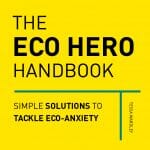How Our Eco Efforts Affect Animals

How Our Eco Efforts Affect Animals
You might be surprised to find how a few minor changes in your life can help protect animals in the area. In a new book from Tessa Wardly, The Eco-Hero Handbook (Leaping Hare Press) outlines a few lifestyle changes the make the environment more wildlife-friendly.
Can my Eco Efforts avoid wildlife being harmed when I go out?
It seems everywhere we humans go, we damage and destroy parts of the natural world. I love being out in the countryside and enjoying wild places, but I’m so worried about the impact we are having on the planet I hardly dare go out.
What to do?
It’s crucial for our health and wellbeing to get out into the natural world – and the more time we spend with wildlife, the more we understand and appreciate it. Rather than becoming too worried about harming wildlife, there are some simple codes of practice Eco Efforts, or you – and your children and pets if they’re out with you – can follow.
Every one of us has a responsibility to protect the countryside. The general ethics of treading lightly and leaving no trace – neatly summed up by ‘take only photos, leave only footprints – will cover most eventualities. This means not damaging or removing natural features that we see and appreciate – including plants, rocks, and trees –all homes to wildlife and form an integral part of a functioning ecosystem. This is demonstrated if we move a rock or log. We immediately realize we are disturbing the home of small animals or insects, putting it back in place gently.
Similarly, take home your leftover food and packaging to dispose of it responsibly.
Everyone dislikes seeing litter in the countryside, and it can injure or harm wildlife.
In your Eco Efforts avoid naked flames and put cigarettes out carefully.
We’ve all seen the devastating effects fires can have on nature and property. Please don’t risk being the person who starts one.
Stick to paths unless more comprehensive access is permitted. This will prevent excessive wear and tear in wild places and disturb ground-nesting birds or breeding wildlife (particularly if you have a dog with you).
If you come across wild animals, give them space and cherish the moment. Just watch and enjoy them quietly from a distance. Try not to get between them and their escape route, which might be the sea for a seal or unfenced woodland for a deer.
My local area is covered in litter. What can I do?
Litter is an eyesore, extremely hazardous to wildlife, and much that is not biodegradable ends up polluting our waterways. What can we all do to solve this problem and safely dispose of rubbish without relying on hugely expensive clean-up operations?
A Litter Solution:
The most common object found during litter clean-up is fast-food packaging, which attracts hungry animals. Small animals get inside bags, cups, cans, bottles, and jars and either become trapped or choke when they try to eat wrappers and bags. Many of them also get entangled in discarded balloons, can-holders, elastic bands, or fishing tackle. They can be injuring or even strangles as they struggle to get free. At the same time, broken glass bottles cause cuts and injuries. So take responsibility for your rubbish by disposing of it properly – ideally by recycling. Keep a bag in the car for rubbish, so you are not tempted to throw it out the window. Simple things like knotting plastic bags, deflating balloons, and snipping up elastic bands and can-holders can reduce wildlife hazards if the waste does end up in the environment.
Next, encourage others to act responsibly.
Do some litter picking – either on your own or by joining or organizing your own community litter pick. Local councils will often lend equipment to keep you safe. It’s satisfying to be taking action, and have our own Eco Efforts. Other people may take the hint – a clean area is less likely to attract more litter.
People’s main reasons for littering are lack of readily available bins and being too lazy to find one. The solution is to lobby your council for visible recycling and rubbish bins in locations that attract most litter. Report anyone persistently littering. If you pick up litter, check where it came from: packaging, cups, and bags are often branded. Visit shops and outlets that are a key source of litter and ask them to use biodegradable materials. Provide bins for recycling and run education campaigns informing customers of how and where they should dispose of the packaging. Waste strategies now put the onus for packaging waste on the companies that produce the packaging, giving it back to them.
How can I ensure my dog’s waste isn’t a health hazard?
Dog waste is unattractive and messy; it is also an environmental pollutant. Nutrients in their waste disrupt the natural balance. Simultaneously, bacteria, parasites, and other disease vectors wash into waterways, posing a danger to wildlife, domestic animals, and people.
The answer is clear, and it’s often the law. For all urban spaces, popular dog-walking areas, and land used for livestock,53 collect and bag all dog mess and bin, it or take it home and dispose of responsibly.
The code in wilderness areas away from urban centers or farm animals is more debatable; here, a ‘stick and flick’ approach could be better than more plastic bags. This is a judgment call, but it’s easy to underestimate dogs’ numbers sharing the same space daily. One study suggests the carrying capacity (a load of a pollutant natural ecosystems can cope with) is just two dog poops a day per square mile.
Never be tempted to collect dog waste in a bag, then leave it on the ground, on a tree, or in the undergrowth. You create a poo bomb wrapped in a highly persistent plastic casing. Even biodegradable bags may be present after three years. The compostable ones persist for more than a year.
Ideally, the default is: always to pick up dog mess in urban areas, on land grazed by livestock. Also anywhere popular with other dog walkers. The best option would be to bury all your dog’s deposits in more remote areas to minimize local waterways and wildlife risk.
Copyright 2021 Reprinted with permission from Leaping Hare Press, an imprint of The Quarto Group
The Eco-Hero Handbook
Simple Solutions to Tackle Eco-Anxiety (Ivy Press / March 16, 2021 / $14.99). This is a pocket guide to taking positive action in the current global warming crisis. It contains practical things, Eco Efforts, that every reader can do to help. As we face a global environmental problem, this book addresses all your eco-anxieties and dilemmas to empower you to become part of the solution.
of the solution.
Tessa Wardley helps you, to look behind the slogans and exploring the myths. This handy guide offers a clear and balanced exploration of the significant eco-debates. This is a book that enables you to make decisions based on facts. Featuring practical steps for positive action in all areas of your life, find solutions to all your environment-related challenges.
About the author:
 Tessa Wardley is a river-lover and mini-adventurer who has worked and played in waters worldwide from New Zealand to the Arctic Circle. Wardley is also a renowned global environmental policy consultant, and before that, the policy advisor to the UK’s Environment Agency. She wrote The River Book, The Woodland Book, and The Countryside Book, The Mindful Art of Wild Swimming, and Mindful Thoughts for Runners.
Tessa Wardley is a river-lover and mini-adventurer who has worked and played in waters worldwide from New Zealand to the Arctic Circle. Wardley is also a renowned global environmental policy consultant, and before that, the policy advisor to the UK’s Environment Agency. She wrote The River Book, The Woodland Book, and The Countryside Book, The Mindful Art of Wild Swimming, and Mindful Thoughts for Runners.
You May Like to Read: Wildlife Dharma: Animal Suffering
Ministry Earth is a collective Awareness-Raising, Perception-Building Initiative from Humanity Healing International, Cathedral of the Soul Educational outreaches created to introduce the perspective of Ethical Consciousness and Nonhuman Personhood to its Animal & Eco Ministries. Ministry Earth is a Service-Oriented Initiative and its Magazine is a Copyrighted Publication of OMTimes Media, Inc. Broadcasting and Publishing House.







